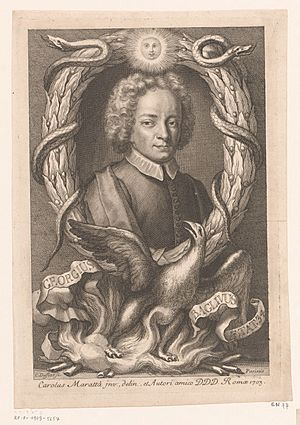Giorgio Baglivi facts for kids
Quick facts for kids
Giorgio Baglivi
|
|
|---|---|

Giorgio Baglivi
|
|
| Born | September 8, 1668 |
| Died | June 15, 1707 |
| Nationality | Italian |
| Scientific career | |
| Fields | Pathology |
Giorgio Baglivi was a very important doctor and scientist from the 1600s. He was born in Ragusa (which is now Dubrovnik, Croatia) and later became famous in Italy. Baglivi taught doctors to learn from careful observation and experiments, instead of just following old ideas.
He believed that the solid parts of our bodies, like muscles and organs, were more important for health than the body's fluids. This was a new idea at the time. Baglivi also used microscopes to study tiny parts of the body, like muscles and nerves. He made many big discoveries that changed how people understood medicine.
Contents
Life of Giorgio Baglivi
Giorgio Baglivi was born on September 8, 1668. His birth name was Giorgio Armeno. His parents were merchants, but they were not rich. Sadly, both of his parents died when he was very young, in 1670. Giorgio and his younger brother, Jacob, were first raised by their uncle. They went to a school run by Jesuits in Ragusa.
When Giorgio was 15, he and his brother moved to Lecce in Italy. There, they were adopted by a wealthy doctor named Pietro Angelo Baglivi. This is how Giorgio got the name Baglivi.
Giorgio's Studies and Early Work
Giorgio studied medicine at several famous universities. These included the University of Salerno, University of Padua, and University of Bologna. He also worked in hospitals in many Italian cities. He even traveled to the Netherlands and England to learn more.
From a young age, Baglivi was very curious. As early as 1685, he started doing experiments on animals. He would inject different things into dogs and study tarantulas. Between 1689 and 1691, he performed many autopsies (examining bodies after death) and dissected animals. He studied how the brain's covering (called dura mater) worked. He also looked into how different drugs affected the body.
Baglivi noticed that what he saw in his research didn't always match what doctors were doing. He thought doctors were too focused on old theories. He believed they should pay more attention to what they observed in real patients. This idea became a main point in his book, On Medical Practice, which he wrote in 1696.
Working with Famous Scientists
In 1691, Baglivi became an assistant to Marcello Malpighi, a very famous scientist. The next year, he followed Malpighi to Rome. Malpighi became the main doctor for the pope.
While working with Malpighi, Baglivi did more experiments. He studied how blood moves in frogs. He also injected medicines into dogs and studied their nerves. He used a microscope to look closely at muscles and the brain.
When Malpighi died in 1694, Baglivi performed his autopsy. He carefully described what caused Malpighi's death. In Rome, Baglivi became friends with other important scientists of his time.
Becoming a Professor and Royal Society Member
In 1695, Baglivi became a doctor for Pope Innocent XIII. The next year, he became a professor of anatomy at the College of Sapienza in Rome. This was a big achievement!
His lectures and medical advice became famous all over Europe. In 1698, he was chosen to be a Fellow of the Royal Society in England. This is a very respected group of scientists. He also joined other important academies in Europe.
Baglivi continued to use his microscope to study the body. He looked at things like saliva, bile, and blood. He died in Rome on June 15, 1707.
Giorgio Baglivi's Works
Baglivi's ideas were similar to those of another scientist, Santorio Santorio. Baglivi believed the body worked like a machine. He thought that understanding how the body's parts moved and worked together was key to understanding health. This idea is called biomechanicism.
He liked to use mathematics and measurements in medicine. He saw the body's processes, like digestion or blood flow, as mechanical actions.
A collection of his writings in Latin was published in 1704. His collected works were reprinted many times and translated into Italian, French, German, and English. This shows how important his ideas were to doctors and scientists across Europe.
See also

